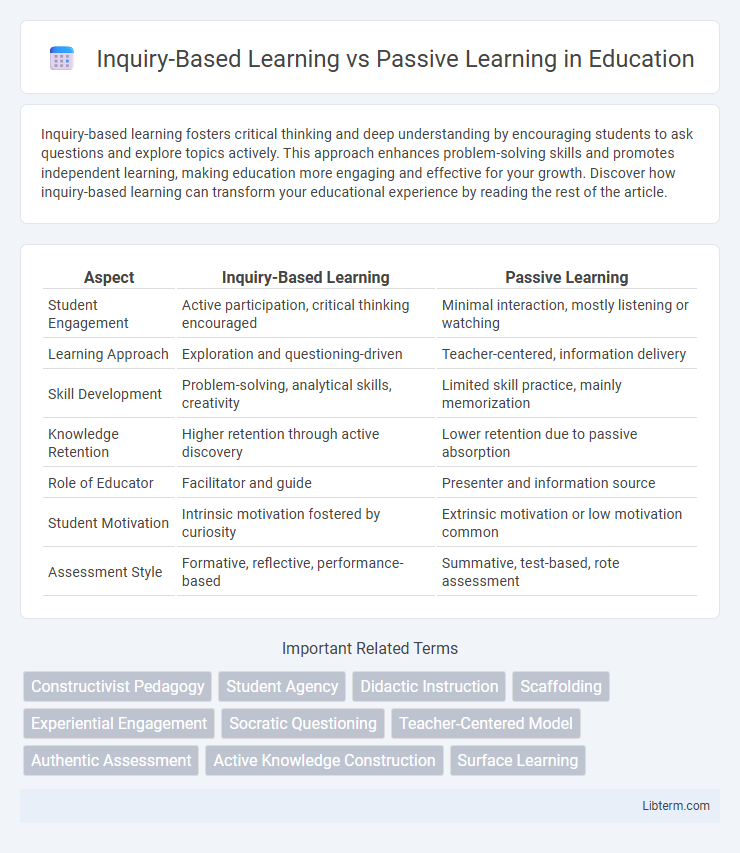Inquiry-based learning fosters critical thinking and deep understanding by encouraging students to ask questions and explore topics actively. This approach enhances problem-solving skills and promotes independent learning, making education more engaging and effective for your growth. Discover how inquiry-based learning can transform your educational experience by reading the rest of the article.
Table of Comparison
| Aspect | Inquiry-Based Learning | Passive Learning |
|---|---|---|
| Student Engagement | Active participation, critical thinking encouraged | Minimal interaction, mostly listening or watching |
| Learning Approach | Exploration and questioning-driven | Teacher-centered, information delivery |
| Skill Development | Problem-solving, analytical skills, creativity | Limited skill practice, mainly memorization |
| Knowledge Retention | Higher retention through active discovery | Lower retention due to passive absorption |
| Role of Educator | Facilitator and guide | Presenter and information source |
| Student Motivation | Intrinsic motivation fostered by curiosity | Extrinsic motivation or low motivation common |
| Assessment Style | Formative, reflective, performance-based | Summative, test-based, rote assessment |
Understanding Inquiry-Based Learning
Inquiry-Based Learning fosters critical thinking and active engagement by encouraging students to explore questions, investigate problems, and construct knowledge through hands-on experiences. Unlike Passive Learning, which relies heavily on memorization and teacher-led instruction, Inquiry-Based Learning promotes deeper comprehension and retention by involving learners directly in the discovery process. Research shows that this method enhances problem-solving skills and adaptability, preparing students for real-world challenges.
Defining Passive Learning
Passive learning is a traditional educational approach where students primarily receive information through lectures or reading without active engagement or critical thinking. It involves minimal interaction, with learners absorbing content passively rather than exploring or questioning material. This method contrasts sharply with inquiry-based learning, which emphasizes active participation and deeper comprehension through exploration and inquiry.
Core Principles of Inquiry-Based Approaches
Inquiry-based learning centers on student-driven exploration, emphasizing curiosity, questioning, and active problem-solving to construct knowledge. Core principles include fostering critical thinking, promoting hands-on investigations, and encouraging reflection to deepen understanding. This approach contrasts passive learning, where students primarily receive and memorize information without engaging in meaningful inquiry.
Characteristics of Passive Learning Environments
Passive learning environments typically feature a learner's limited engagement, where information is received through lectures or presentations without active participation. These settings emphasize memorization and note-taking, with minimal opportunities for questioning or critical thinking. The lack of interaction and feedback in passive learning often results in lower retention and reduced development of problem-solving skills.
Cognitive Engagement: Active vs Passive
Inquiry-based learning significantly enhances cognitive engagement by encouraging students to actively explore, question, and analyze information, leading to deeper understanding and critical thinking skills. Passive learning, by contrast, involves students receiving information without active participation, which often results in lower retention and minimal cognitive processing. Research shows that active engagement in inquiry-based learning promotes higher-order thinking and better knowledge application compared to passive absorption of content.
Student Motivation and Ownership
Inquiry-based learning fosters higher student motivation by actively engaging learners in questioning, exploring, and problem-solving, which cultivates a sense of ownership over their educational journey. Passive learning often leads to diminished motivation as students assume a more receptive role, limiting their personal connection to the material. Research shows that students involved in inquiry-based approaches demonstrate increased intrinsic motivation and accountability for their learning outcomes.
Teacher’s Role in Both Learning Methods
In inquiry-based learning, the teacher acts as a facilitator who guides students through questioning, exploration, and critical thinking, fostering active engagement and deeper understanding. In contrast, during passive learning, the teacher primarily delivers information through lectures, with students receiving content without significant interaction or critical analysis. The teacher's role in inquiry-based learning emphasizes mentorship and support, whereas in passive learning, it centers on knowledge transmission and content delivery.
Impact on Critical Thinking Skills
Inquiry-based learning significantly enhances critical thinking skills by encouraging students to ask questions, analyze information, and develop problem-solving abilities through active engagement. In contrast, passive learning often leads to surface-level understanding as students primarily receive information without deep cognitive processing. Research shows that active involvement in inquiry-based approaches fosters higher-order thinking and better long-term retention compared to traditional passive methods.
Learning Outcomes: Inquiry-Based vs Passive
Inquiry-based learning significantly enhances critical thinking, problem-solving skills, and knowledge retention compared to passive learning, which often results in limited engagement and superficial understanding. Students engaged in inquiry-based approaches demonstrate higher academic achievement and deeper conceptual mastery due to active participation and discovery. Passive learning methods, such as lecture-based instruction, typically lead to lower information retention rates and minimal development of analytical skills.
Best Practices for Integrating Inquiry Approaches
Integrating inquiry-based learning into classrooms requires designing open-ended questions that stimulate critical thinking and encourage student exploration. Educators should incorporate collaborative projects and real-world problem-solving tasks to deepen engagement and foster active knowledge construction. Providing timely feedback and scaffolding supports helps students develop inquiry skills while maintaining motivation and confidence throughout the learning process.
Inquiry-Based Learning Infographic

 libterm.com
libterm.com